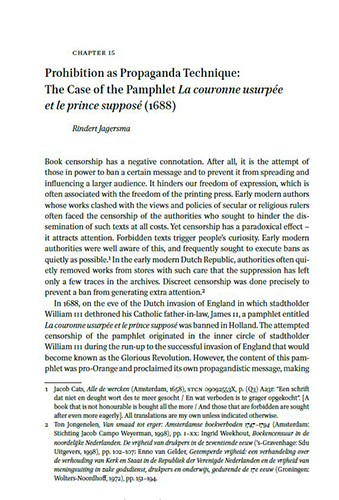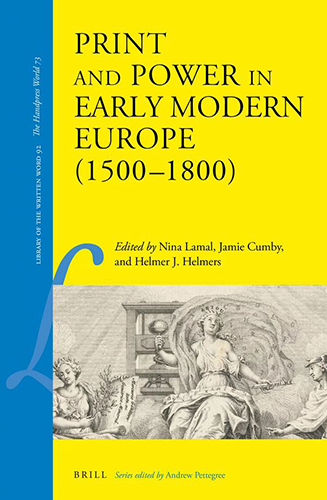

Rindert Jagersma
Prohibition as a propaganda technique: the case of the pamphlet La couronne usurpee et le prince supposé (1688)
In: Nina Lamal, Jamie Cumby, and Helmer J. Helmers (eds.), Print and Power in Early Modern Europe (1500-1800) (Leiden : Brill, 2020), pp. 338-357.
Chapter 15 | Library of the Written Word (LWW), volume: 92.
ISBN: 978-90-04-44888-9 (hardback) | 978-90-04-44889-6 (e-book, PDF)
DOI: https://doi.org/10.1163/9789004448896_017
Link: https://brill.com/view/book/edcoll/9789004448896/BP000024.xml
Abstract:
Book censorship has a negative connotation. After all, it is the attempt of those in power to ban a certain message and to prevent it from spreading and influencing a larger audience. It hinders our freedom of expression, which is often associated with the freedom of the printing press. Early modern authors whose works clashed with the views and policies of secular or religious rulers often faced the censorship of the authorities who sought to hinder the dissemination of such texts at all costs. Yet censorship has a paradoxical effect – it attracts attention. Forbidden texts trigger people’s curiosity. Early modern authorities were well aware of this, and frequently sought to execute bans as quietly as possible. In the early modern Dutch Republic, authorities often quietly removed works from stores with such care that the suppression has left only a few traces in the archives. Discreet censorship was done precisely to prevent a ban from generating extra attention.
In 1688, on the eve of the Dutch invasion of England in which stadtholder William III dethroned his Catholic father-in-law, James II, a pamphlet entitled La couronne usurpée et le prince supposé was banned in Holland. The attempted censorship of the pamphlet originated in the inner circle of stadtholder William III during the run-up to the successful invasion of England that would become known as the Glorious Revolution. However, the content of this pamphlet was pro-Orange and proclaimed its own propagandistic message, making a ban on this specific pamphlet seem strange. In this article, I will show that the prohibition served two purposes. On the one hand, the Dutch Republic appeared to distance itself from the content to create goodwill amongst ambassadors and foreign rulers. On the other hand, by deliberately imposing censorship, it was an attempt to generate extra attention on the domestic market for the pamphlet, the dissemination of which was not actively stopped after the ban was issued.
This article is Open Access available.
Link to volume: https://brill.com/view/title/59640
Read online: Full Text
Direct download: PDF (0,2 MB)
This publication was the result of the conference ‘Print and Power’, University of St Andrews, 21-23 June 2018.
Abstract of volume:
Print, in the early modern period, could make or break power. This volume addresses one of the most urgent and topical questions in early modern history: how did European authorities use a new medium with such tremendous potential? The eighteen contributors develop new perspectives on the relationship between the rise of print and the changing relationships between subjects and rulers by analysing print’s role in early modern bureaucracy, the techniques of printed propaganda, genres, and strategies of state communication. While print is often still thought of as an emancipating and disruptive force of change in early modern societies, the resulting picture shows how instrumental print was in strengthening existing power structures.
Illustration:
Portret van Willem III (1650-1702), prins van Oranje, Willem Wissing (manier van), 1680 – 1710. Rijksmuseum, SK-A-879